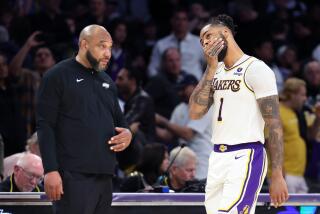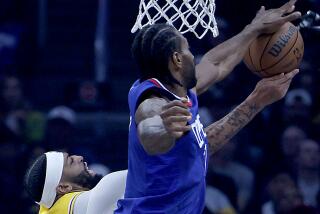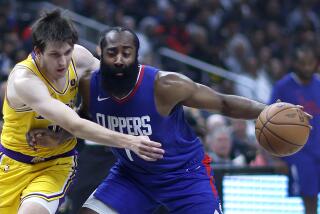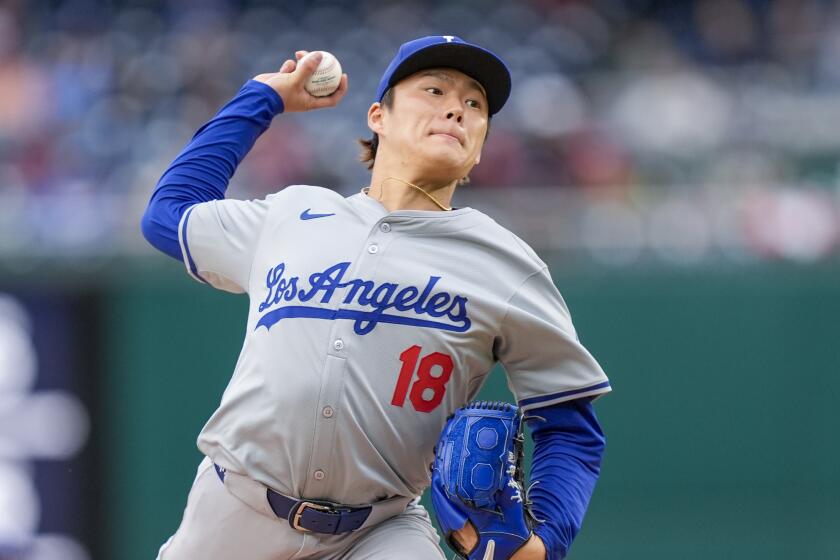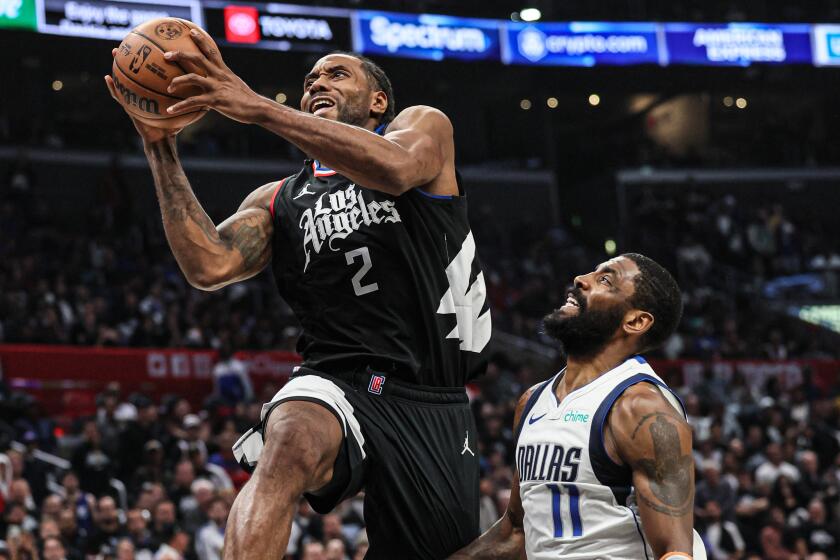Win or lose, they want the ball at game’s end
The shots weren’t falling for Kobe Bryant.
Not the three-pointers, the turnaround fadeaways or even the short pull-up jumpers.
The Lakers star had missed 18 of his first 20 shots last month in a game against New Orleans that threatened to turn into a horrid loss against the team with the worst record in the Western Conference.
With the Lakers trailing by two points and fewer than 30 seconds to play, the Lakers needed a basket. There was no doubt to whom they would look to make it.
Bryant rose up from beyond the three-point arc and buried a jumper, surprising none of his teammates.
“The guy was struggling all night,” Lakers point guard Ramon Sessions recalled this week. “Any ordinary player, their confidence may be down and they may not want to take those shots, but he stepped right in and does what he does.”
Being one of the NBA’s top closers means having the courage to miss in crucial situations, even in the playoffs with a season hanging in the balance.
Of course, it seems as if they rarely do.
Chris Paul scored nine of the Clippers’ final 11 points this month in a taut victory over Oklahoma City, one of a handful of recent late-game scoring binges for the dynamic point guard. He also had 13 points in the fourth quarter of a come-from-behind victory over New Orleans and 12 points in the last 12 minutes of a triumph against Golden State.
“That’s what star players do,” Clippers Coach Vinny Del Negro said of Paul’s clutch playmaking. “You can take one thing away, but they read it and they can make the play. Obviously, Chris isn’t going to jump over you. He’s got to outsmart you a little bit and he’s very clever with his footwork.”
The game’s top closers each feature their own distinctive styles.
TNT analyst and former NBA forward Chris Webber said the most clutch players in the league are Bryant because of his shot-making ability, Oklahoma City’s Kevin Durant because of his pure shooting stroke and New York’s Carmelo Anthony because of his tendency “to score and do what he does out there.”
Dirk Nowitzki continually made the big plays throughout Dallas’ championship run last year, reaching double digits in scoring 12 times in the fourth quarter of 21 playoff games. Making the 7-footer nearly impossible to stop was his one-legged, step-back fadeaway jumper combined with the ability to drive if he felt a defender was not giving him the space to shoot from the outside.
Sometimes being a closer means letting someone else apply the finishing touches.
“Your ability late, it’s not just to take and make shots,” said ABC/ESPN analyst Jeff Van Gundy, who also coached the Knicks to the 1999 Finals. “It’s to make the right plays to allow your team to get the best possible shot attempts.”
That’s where guys like Derek Fisher and Robert Horry come in.
Nearly an afterthought on a team that included Bryant, Shaquille O’Neal, Karl Malone and Gary Payton, Fisher forever endeared himself to Lakers fans with a game-winning three-pointer with 0.4 seconds left against San Antonio in Game 5 of the 2004 Western Conference semifinals.
Horry, who rarely started for the Lakers, had an incredible stretch of making a game-clinching three-pointer in at least one game in four consecutive playoff series starting with the 2001 Finals.
“People say a certain guy has to shoot the ball” at the end of games, Van Gundy said. “That’s absurd. What you try to direct as a coach in those situations is who gets the ball on the first pass and where they get the ball.
“From there, the defense dictates what shot is taken. So then you need Fisher and Horry to have the basketball courage to step forward and maybe take a shot where maybe they haven’t had one in four, five, six, seven minutes.”
LeBron James seemed to lose his hoops heroism in last year’s Finals after having been repeatedly clutch in helping Miami get there. He deferred to teammates and looked almost afraid to shoot, a development that Van Gundy acknowledged was “perplexing” but said led to unfair criticism as the Heat wilted against the Mavericks.
“Like, what, the Eastern Conference finals and [previous] one-possession games aren’t important?” Van Gundy said. “We’re going to overlook those because we’re going to focus on what we see as his failures? You don’t get to the Finals without James.”
Lakers Coach Mike Brown, who also coached James for five seasons in Cleveland, said his former star had a different approach in closing time than Bryant, his current star.
“LeBron is a guy that is more of a facilitator but has hit big shots,” Brown said, “and Kobe is a guy that’s more of a scorer but has made some passes to guys to where they’ve hit big shots. So just a little bit different mentality or psyche at the end of the games.”
There is one quality the best closers share: the desire to have the ball in their hands at the end of games.
“Be aggressive,” Paul said. “It’s just keep playing the game. It’s a long game, sometimes you’re going to make shots and stuff like that. At the end of the day, you have to do whatever you have to do to win.”
Making pressure shots has become routine to Bryant.
He made consecutive three-pointers in the final 1:20 of regulation Sunday during a double-overtime victory over Oklahoma City, including a running one-footer as the shot clock expired.
It’s nothing new for him. After making a 22-foot jumper over the Clippers’ Randy Foye with 24.5 seconds left to help secure a victory earlier this month, Bryant was asked if the moment was extra special.
“Not really,” Bryant said. “Same-old, same-old.”
Times staff writer Baxter Holmes contributed to this report.
More to Read
Get our high school sports newsletter
Prep Rally is devoted to the SoCal high school sports experience, bringing you scores, stories and a behind-the-scenes look at what makes prep sports so popular.
You may occasionally receive promotional content from the Los Angeles Times.
